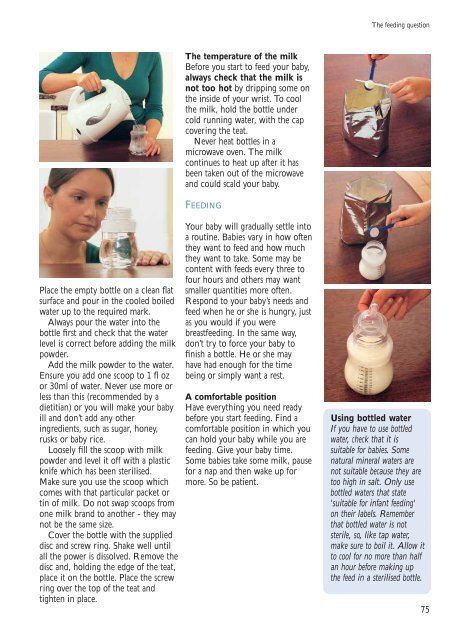here - Health Promotion Agency
here - Health Promotion Agency
here - Health Promotion Agency
Create successful ePaper yourself
Turn your PDF publications into a flip-book with our unique Google optimized e-Paper software.
The feeding question<br />
The temperature of the milk<br />
Before you start to feed your baby,<br />
always check that the milk is<br />
not too hot by dripping some on<br />
the inside of your wrist. To cool<br />
the milk, hold the bottle under<br />
cold running water, with the cap<br />
covering the teat.<br />
Never heat bottles in a<br />
microwave oven. The milk<br />
continues to heat up after it has<br />
been taken out of the microwave<br />
and could scald your baby.<br />
Place the empty bottle on a clean flat<br />
surface and pour in the cooled boiled<br />
water up to the required mark.<br />
Always pour the water into the<br />
bottle first and check that the water<br />
level is correct before adding the milk<br />
powder.<br />
Add the milk powder to the water.<br />
Ensure you add one scoop to 1 fl oz<br />
or 30ml of water. Never use more or<br />
less than this (recommended by a<br />
dietitian) or you will make your baby<br />
ill and don’t add any other<br />
ingredients, such as sugar, honey,<br />
rusks or baby rice.<br />
Loosely fill the scoop with milk<br />
powder and level it off with a plastic<br />
knife which has been sterilised.<br />
Make sure you use the scoop which<br />
comes with that particular packet or<br />
tin of milk. Do not swap scoops from<br />
one milk brand to another - they may<br />
not be the same size.<br />
Cover the bottle with the supplied<br />
disc and screw ring. Shake well until<br />
all the power is dissolved. Remove the<br />
disc and, holding the edge of the teat,<br />
place it on the bottle. Place the screw<br />
ring over the top of the teat and<br />
tighten in place.<br />
FEEDING<br />
Your baby will gradually settle into<br />
a routine. Babies vary in how often<br />
they want to feed and how much<br />
they want to take. Some may be<br />
content with feeds every three to<br />
four hours and others may want<br />
smaller quantities more often.<br />
Respond to your baby’s needs and<br />
feed when he or she is hungry, just<br />
as you would if you were<br />
breastfeeding. In the same way,<br />
don’t try to force your baby to<br />
finish a bottle. He or she may<br />
have had enough for the time<br />
being or simply want a rest.<br />
A comfortable position<br />
Have everything you need ready<br />
before you start feeding. Find a<br />
comfortable position in which you<br />
can hold your baby while you are<br />
feeding. Give your baby time.<br />
Some babies take some milk, pause<br />
for a nap and then wake up for<br />
more. So be patient.<br />
Using bottled water<br />
If you have to use bottled<br />
water, check that it is<br />
suitable for babies. Some<br />
natural mineral waters are<br />
not suitable because they are<br />
too high in salt. Only use<br />
bottled waters that state<br />
'suitable for infant feeding'<br />
on their labels. Remember<br />
that bottled water is not<br />
sterile, so, like tap water,<br />
make sure to boil it. Allow it<br />
to cool for no more than half<br />
an hour before making up<br />
the feed in a sterilised bottle.<br />
75

















